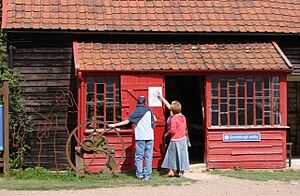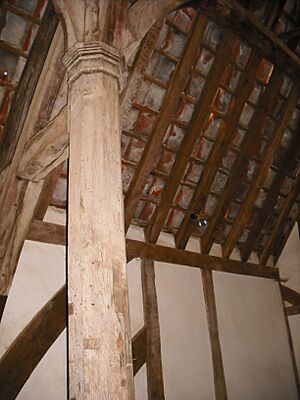The Food Museum facts for kids

Abbot's Hall
|
|
| Lua error in Module:Location_map at line 420: attempt to index field 'wikibase' (a nil value). | |
| Former name | Museum of East Anglian Life |
|---|---|
| Established | 1967 |
| Location | Iliffe Way, Stowmarket, Suffolk, England |
| Type | Food museum |
| Collection size | Over 40,000 objects |
The Food Museum in Stowmarket, Suffolk, England, is a special place. It used to be called the Museum of East Anglian Life. This museum teaches you all about farming and how our food is made. It's a big place, with 84 acres of land and 17 old buildings to explore.
Contents
History of The Food Museum
The land where the museum stands was once part of the Abbot’s Hall estate. This estate has a long history, going back to medieval times. It was owned by many different families over the years.
A farmer named Jack Carter and others wanted to save old objects from rural East Anglia. They held temporary exhibitions for a few years. Then, in 1967, Vera and Ena Longe gave 1.38 acres of land for a permanent museum. This land included Stowmarket's oldest building, a medieval barn. The museum officially opened that year.
In 1970, the Longe sisters put the rest of their land into a trust. This included 75 acres of farmland and the historic Abbot’s Hall house. Over the next 30 years, more land was added to the museum. After the Longe sisters passed away, the full estate was leased to the museum in 2004. In April 2022, the museum changed its name to The Food Museum.
Buildings to Explore
The Food Museum has many interesting buildings on its 84-acre site. Here are some of them:
- William Bone Gallery - This is a modern building. It hosts the museum's yearly exhibitions. It also has a kitchen where you can see cooking demonstrations.
- Abbot's Hall - This Queen Anne style house shows what homes in East Anglia were like. It also has spaces for temporary art shows.
- Edgar's Farmhouse - This farmhouse dates back to the 1300s. It was moved from Combs to the museum in 1970. It was the first old building rebuilt on the site.
- Crowe Street Cottages - These were homes for workers on the Abbot's Hall Estate. They are kept just as they were when the last dairy workers lived there.
- Boby Building - Here you can see old farm engines. There are also workshops for different crafts. You can even see a working printing press.
- Eastbridge Windpump - This windpump was used in the 1800s to drain water from land.
- Alton Watermill - This 18th-century watermill ground corn. Like many museum buildings, it was taken apart and moved here. It was saved from being destroyed by the Alton Water Reservoir.
Restoring Abbot's Hall
The museum received a special grant to fix up Abbot's Hall and Crowe Street Cottages. This project finished in April 2012. It officially opened in June 2012. Now, Abbot's Hall has nine exhibition rooms. These rooms explore what "home" means in East Anglia. Crowe Street Cottages show how workers lived long ago.
You can visit Abbot's Hall all year round with your museum ticket. It has a special exhibit about George Ewart Evans. He was a famous storyteller and collector of old traditions.
The Food Museum's Growth
In 2018, the museum started a big plan to become The Food Museum. They began many new projects. These included fixing the Alton Watermill and Eastbridge Windpump so they could work again. They also built a new Farm Barn. This barn holds some of the museum's farming tools. The William Bone Gallery was also updated for new exhibitions.
In 2023, the museum started building new visitor facilities. They also worked to protect the Medieval Barn. New exhibition spaces were also part of this plan.
Fun Events at the Museum
Since becoming The Food Museum in 2022, the museum has daily talks and activities. These focus on farming, animals, and cooking. The museum also offers cooking workshops and family activities. They host large events throughout the year.
Every year since 1996, the museum has hosted a Festival of Beer and Brewing. This event showcases drinks from small, independent breweries. The museum also hosts the Primadonna Festival, a literature festival, each summer. Another event is the East Anglian Storytelling Festival.




